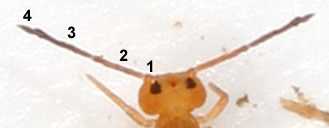| Checklist of the Collembola: Key to the common surface dwelling Collembola from North America |
This key is still under construction. Note that missing figures will be provided as soon as possible. Currently, the key is in the feasibility study phase to find out how to integrate in the checklist in a modular way a key that has been generated with DELTA.
Kenneth A. Christiansen,
Department of Biology, Grinnell College, PO Box V3, Grinnell, IA 50112-0806, USA
Frans Janssens,
Department of Biology, University of Antwerp, Antwerp, B-2020, Belgium
Definitions
Common: found by BugGuide contributors.
Surface dwelling: living and actively crawling on the surface of things,
such as on water surfaces, on vegetation, on rocks, on bark of trees,
on walls of houses; also hiding under bark, stones, vegetation, in leaf litter,
in houses.
1(0). Abdominal tergal segmentation distinct (fig.1a); trunk elongate (fig.2a)......................................... 2 Abdominal tergal segmentation indistinct (fig.1b); trunk subglobular (fig.2b)..................................... 11 |
|
 |
|
 |
|
2(1). Antennae long; legs long; prothoracic tergum indistinct (fig.3b).................................................. 3 Antennae short; legs short; prothoracic tergum distinct (fig.3a).................................................. 6 |
|
 |
|
3(2). Third antennal segment much longer than other antennal segments (fig.4)............................... Tomoceridae Third antennal segment subequal to other antennal segments (fig.3b).................................................. 4 |
|
 |
|
4(3). Fourth abdominal segment distinctly longer than other abdominal segments (fig.3b)............................... 5 Fourth abdominal segment subequal to other abdominal segments (fig.5)......................................... Isotomidae |
|
 |
|
5(4). Antennae distinctly longer than body (fig.6).... Paronellinae Antennae not distinctly longer than body (fig.3b)............. ............................................. Entomobryidae |
|
 |
|
6(2). Body distinctly tuberculate (fig.7)................ Neanurinae Body not tuberculate........................................ 7 |
|
 |
|
7(6). Antennae not pyramid-shaped................................. 8 Antennae pyramid-shaped: broad at basis, narrow at apex (fig.8)....................................... Odontellidae |
|
 |
|
8(7). Eyes absent (fig.9)............................. Onychiuridae Eyes present................................................ 9 |
|
 |
|
9(8). Body shape long............................................ 10 Body shape short (fig.10)........................... Poduridae |
|
 |
|
10(9). Body setae per segment numerous, 'uncountable' (fig.11)....... ................................................ Neanuridae 1 Body setae per segment sparse, at most in 3 transversal rows (fig.12).................................... Hypogastruridae |
|
 |
|
 |
|
11(1). Antennae as long as or longer than head (fig.13b)........... 12 Antennae shorter than head (fig.13a).................. Neelidae |
|
 |
|
12(11). Fourth antennal segment much shorter than third antennal segment (fig.14)............................... Dicyrtomidae Fourth antennal segment subequal or longer than third antennal segment.................................................. 13 |
|
 |
|
13(12). Abdominal dorsal spinelike macrosetae absent............... 14 Abdominal dorsal spinelike macrosetae distinctly present (fig.15)....................................... Sminthuridae |
|
 |
|
14(13). Fourth antennal segment annulated (fig.16).... Bourletiellidae Fourth antennal segment not annulated (fig.17).... Katiannidae |
|
 |
|
 |
|
Endnotes
1 Neanuridae without tuberculate body.
Bourletiellidae
Abdominal dorsal spinelike macrosetae absent.
Abdominal tergal segmentation indistinct (fig.1b). Antennae as long as or
longer than head (fig.13b). Fourth antennal segment subequal or longer than
third antennal segment. Fourth antennal segment annulated (fig.16). Trunk
subglobular (fig.2b).
Dicyrtomidae
Abdominal tergal segmentation indistinct (fig.1b).
Antennae as long as or longer than head (fig.13b). Fourth antennal segment much
shorter than third antennal segment (fig.14). Trunk subglobular (fig.2b).
Entomobryidae
Abdominal tergal segmentation distinct (fig.1a).
Antennae not distinctly longer than body (fig.3b). Antennae long. Fourth
abdominal segment distinctly longer than other abdominal segments (fig.3b).
Legs long. Prothoracic tergum indistinct (fig.3b). Third antennal segment
subequal to other antennal segments (fig.3b). Trunk elongate (fig.2a).
Hypogastruridae
Abdominal tergal segmentation distinct (fig.1a).
Antennae short. Antennae not pyramid-shaped. Body not tuberculate. Body setae
per segment sparse, at most in 3 transversal rows (fig.12). Body shape long.
Eyes present. Legs short. Prothoracic tergum distinct (fig.3a). Trunk elongate
(fig.2a).
Isotomidae
Abdominal tergal segmentation distinct (fig.1a).
Antennae long. Fourth abdominal segment subequal to other abdominal segments
(fig.5). Legs long. Prothoracic tergum indistinct (fig.3b). Third antennal
segment subequal to other antennal segments (fig.3b). Trunk elongate (fig.2a).
Katiannidae
Abdominal dorsal spinelike macrosetae absent.
Abdominal tergal segmentation indistinct (fig.1b). Antennae as long as or
longer than head (fig.13b). Fourth antennal segment subequal or longer than
third antennal segment. Fourth antennal segment not annulated (fig.17). Trunk
subglobular (fig.2b).
Neanuridae 1
Abdominal tergal segmentation distinct
(fig.1a). Antennae short. Antennae not pyramid-shaped. Body not tuberculate.
Body setae per segment numerous, ’uncountable’ (fig.11). Body shape
long. Eyes present. Legs short. Prothoracic tergum distinct (fig.3a). Trunk
elongate (fig.2a).
Neanurinae
Abdominal tergal segmentation distinct (fig.1a).
Antennae short. Body distinctly tuberculate (fig.7). Legs short. Prothoracic
tergum distinct (fig.3a). Trunk elongate (fig.2a).
Neelidae
Abdominal tergal segmentation indistinct (fig.1b).
Antennae shorter than head (fig.13a). Trunk subglobular (fig.2b).
Odontellidae
Abdominal tergal segmentation distinct (fig.1a).
Antennae short. Antennae pyramid-shaped: broad at basis, narrow at apex
(fig.8). Body not tuberculate. Legs short. Prothoracic tergum distinct
(fig.3a). Trunk elongate (fig.2a).
Onychiuridae
Abdominal tergal segmentation distinct (fig.1a).
Antennae short. Antennae not pyramid-shaped. Body not tuberculate. Eyes absent
(fig.9). Legs short. Prothoracic tergum distinct (fig.3a). Trunk elongate
(fig.2a).
Paronellinae
Abdominal tergal segmentation distinct (fig.1a).
Antennae distinctly longer than body (fig.6). Antennae long. Fourth abdominal
segment distinctly longer than other abdominal segments (fig.3b). Legs long.
Prothoracic tergum indistinct (fig.3b). Third antennal segment subequal to
other antennal segments (fig.3b). Trunk elongate (fig.2a).
Poduridae
Abdominal tergal segmentation distinct (fig.1a).
Antennae short. Antennae not pyramid-shaped. Body not tuberculate. Body shape
short (fig.10). Eyes present. Legs short. Prothoracic tergum distinct
(fig.3a). Trunk elongate (fig.2a).
Sminthuridae
Abdominal dorsal spinelike macrosetae distinctly
present (fig.15). Abdominal tergal segmentation indistinct (fig.1b). Antennae
as long as or longer than head (fig.13b). Fourth antennal segment subequal or
longer than third antennal segment. Trunk subglobular (fig.2b).
Tomoceridae
Abdominal tergal segmentation distinct (fig.1a).
Antennae long. Legs long. Prothoracic tergum indistinct (fig.3b). Third
antennal segment much longer than other antennal segments (fig.4). Trunk
elongate (fig.2a).